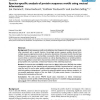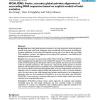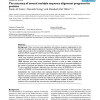2345 search results - page 91 / 469 » Comparing sequence scaffolds |
BMCBI
2005
13 years 7 months ago
2005
Background: Protein sequence motifs are by definition short fragments of conserved amino acids, often associated with a specific function. Accordingly protein sequence profiles de...
WABI
2010
Springer
13 years 6 months ago
2010
Springer
Quantification of selective pressures on regulatory sequences is a central question in studying the evolution of gene regulatory networks. Previous methods focus primarily on sing...
BMCBI
2008
13 years 7 months ago
2008
Background: Biologically active sequence motifs often have positional preferences with respect to a genomic landmark. For example, many known transcription factor binding sites (T...
BMCBI
2006
13 years 7 months ago
2006
Background: Non-coding DNA sequences comprise a very large proportion of the total genomic content of mammals, most other vertebrates, many invertebrates, and most plants. Unravel...
BMCBI
2006
13 years 7 months ago
2006
Background: There have been many algorithms and software programs implemented for the inference of multiple sequence alignments of protein and DNA sequences. The "true" ...



